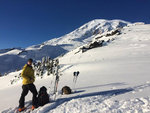

On Feb. 4, the Mount Rainier Nordic Patrol was making it rounds on the slopes near Paradise when they found a skier who’d lost his way.
The skier was in a drainage trying to make his way back to the Paradise parking lot. The volunteers offered help and pointed him in the right direction.
This is not an uncommon occurrence, said Jeff Gardner, patrol supervisor. He estimates the patrol helps two to three parties (some as large as eight people) who are off-course each weekend at Mount Rainier National Park.
“When whiteout conditions come in, a lot of people don’t have a map or compass or GPS,” Gardner said. “The Nordic patrol carries those things so they can help if they come across people who need help.”
The 45-person volunteer unit also sets route signs for established routes, and they help in search and rescue situations.
This winter is Gardner’s third as the patrol’s supervisor. He says he has a strong team but is always looking for volunteers.
Volunteers commit to preseason training and to work at least four days each winter. About two-thirds of the patrol is on skis, and the rest are on snowshoes, Gardner said.
We caught up with Gardner, 41, when the park was closed because of snow. He took a few minutes to field some questions about the Nordic patrol and winter safety.
Q: What do the volunteers typically do?
A: We have three main routes that keep people out of known avalanche terrain. A lot of visitors are unaware that shortly out of the parking lot they can be in avalanche terrain, so these routes help people bypass that terrain and give them a place to go. … There are signs for each of those routes. Each week we might have to go reset the poles so we don’t lose them to too much snow.
After that, we do what’s called preventative search and rescue. They go to where they are going to increase their chances of running into visitors. They talk to people and see where they are going. They offer a map and see if they are wearing the right gear for this environment. No cotton, and they are wearing boots and snowshoes. They try to give them an idea of what they are dealing with.
Then the rest of the time they can go to other spots where, if there is a search and rescue, they will be an asset.
Q: What are the most telltale signs a visitor isn’t prepared?
A: Clothing. You might have a day where you should have a hard-shell layer, and you see people who have jeans and sweaters and nothing to prevent them from getting soaked. Or it’s really windy, and they don’t have something to keep the wind out. Or they don’t have headgear. Or people try to walk without snowshoes or skis.
Q: In addition to dressing correctly, what would you like every visitor to do in terms of safety?
A: I think map, compass and GPS is really a big one.
Q: Where are people most likely to accidentally wander into avalanche terrain?
A: Narada Falls. That hill by the restrooms, the trail will take you up away from the avalanche slope. But a lot of people go directly up to the road, and that’s all avalanche slope. And on the Paradise Valley Road at the slopes at the base of Mazama Ridge.
Q: What about deep snow immersion issues?
A: The tree well issue hasn’t been a big one for us. A lot of people aren’t skiing and going off into areas with tree wells like at a ski resort. Our issue is a lot of times people won’t check the weather for the day. They may see the mountain and think it looks great. They aren’t quite aware of how much snow there is and that all this snow causes higher avalanche possibilities.
If they aren’t skiers they might not think to check NWAC (Northwest Avalanche Center). You don’t need to know anything about avalanches to go to the Northwest Avalanche Center page and get a basic feel. It will show you the color for the area. If it’s orange (considerable), red (high) or black (extreme), it’s not really worth coming to the park. It also means the road crews are working hard to clear the avalanche paths that cross the roads.
If it’s yellow (moderate) and green (low), it’s better.